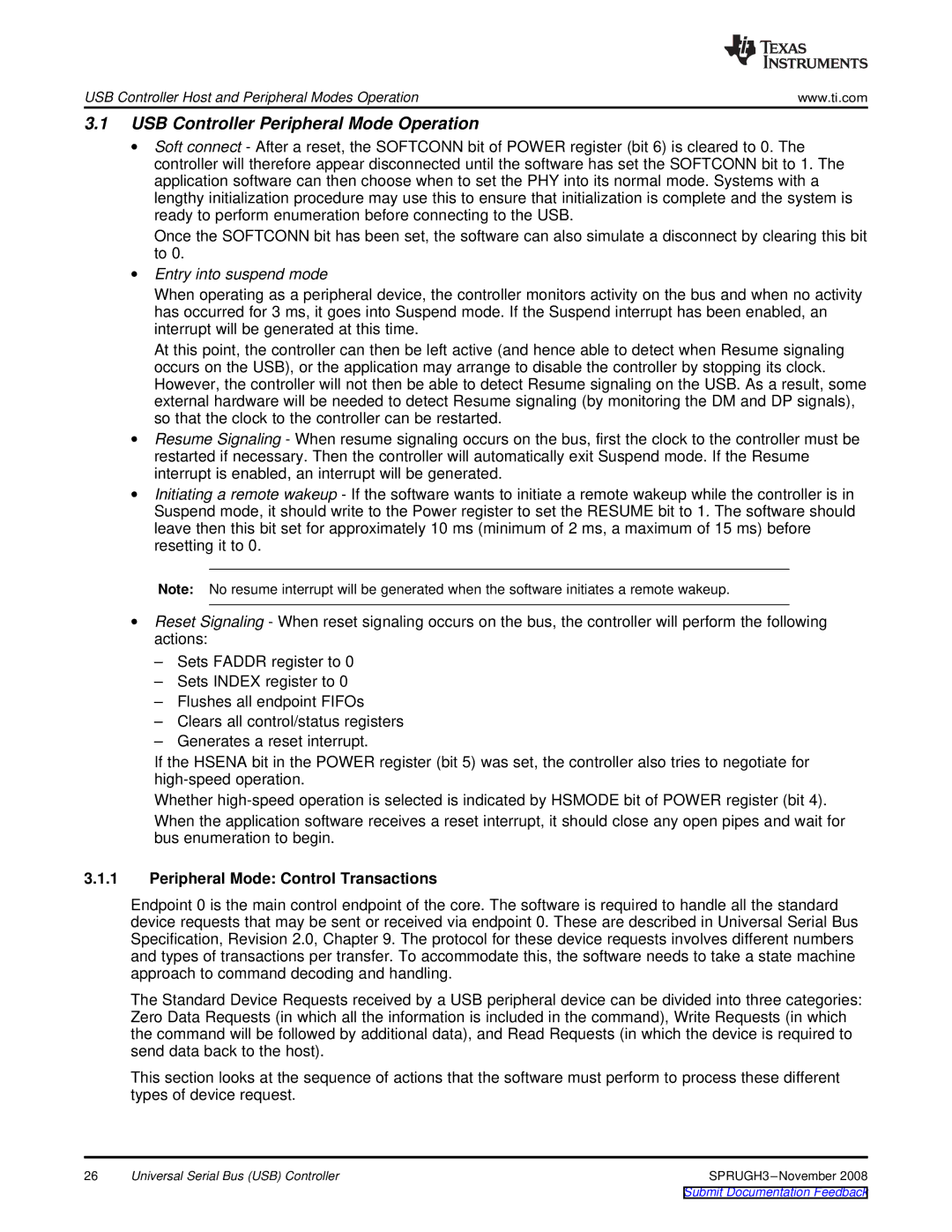
USB Controller Host and Peripheral Modes Operation | www.ti.com |
3.1USB Controller Peripheral Mode Operation
∙Soft connect - After a reset, the SOFTCONN bit of POWER register (bit 6) is cleared to 0. The controller will therefore appear disconnected until the software has set the SOFTCONN bit to 1. The application software can then choose when to set the PHY into its normal mode. Systems with a lengthy initialization procedure may use this to ensure that initialization is complete and the system is ready to perform enumeration before connecting to the USB.
Once the SOFTCONN bit has been set, the software can also simulate a disconnect by clearing this bit to 0.
∙Entry into suspend mode
When operating as a peripheral device, the controller monitors activity on the bus and when no activity has occurred for 3 ms, it goes into Suspend mode. If the Suspend interrupt has been enabled, an interrupt will be generated at this time.
At this point, the controller can then be left active (and hence able to detect when Resume signaling occurs on the USB), or the application may arrange to disable the controller by stopping its clock. However, the controller will not then be able to detect Resume signaling on the USB. As a result, some external hardware will be needed to detect Resume signaling (by monitoring the DM and DP signals), so that the clock to the controller can be restarted.
∙Resume Signaling - When resume signaling occurs on the bus, first the clock to the controller must be restarted if necessary. Then the controller will automatically exit Suspend mode. If the Resume interrupt is enabled, an interrupt will be generated.
∙Initiating a remote wakeup - If the software wants to initiate a remote wakeup while the controller is in Suspend mode, it should write to the Power register to set the RESUME bit to 1. The software should leave then this bit set for approximately 10 ms (minimum of 2 ms, a maximum of 15 ms) before resetting it to 0.
Note: No resume interrupt will be generated when the software initiates a remote wakeup.
∙Reset Signaling - When reset signaling occurs on the bus, the controller will perform the following actions:
–Sets FADDR register to 0
–Sets INDEX register to 0
–Flushes all endpoint FIFOs
–Clears all control/status registers
–Generates a reset interrupt.
If the HSENA bit in the POWER register (bit 5) was set, the controller also tries to negotiate for
Whether
When the application software receives a reset interrupt, it should close any open pipes and wait for bus enumeration to begin.
3.1.1Peripheral Mode: Control Transactions
Endpoint 0 is the main control endpoint of the core. The software is required to handle all the standard device requests that may be sent or received via endpoint 0. These are described in Universal Serial Bus Specification, Revision 2.0, Chapter 9. The protocol for these device requests involves different numbers and types of transactions per transfer. To accommodate this, the software needs to take a state machine approach to command decoding and handling.
The Standard Device Requests received by a USB peripheral device can be divided into three categories: Zero Data Requests (in which all the information is included in the command), Write Requests (in which the command will be followed by additional data), and Read Requests (in which the device is required to send data back to the host).
This section looks at the sequence of actions that the software must perform to process these different types of device request.
26 | Universal Serial Bus (USB) Controller |
